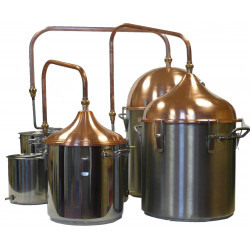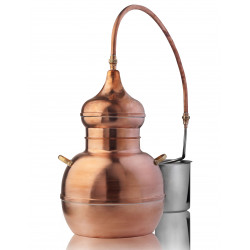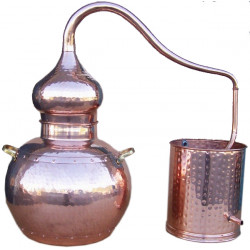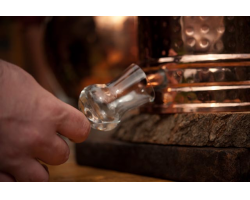The theory of the distillation is quite simple. We heat the substrate forcing it to evaporate, and then we condense the vapor.
Still many types of distillers are known. Why is this difference?
In this article we will try to help you understand the differences of the many distiller types and help you to find the equipment that best suits your needs.
The Material

The distillers are mostly made of copper or stainless steel. However the industrial distillers always use copper stills. It is because copper has several advantages against steel that will contribute to the quality of the distillate.
First, copper has a great heat conductivity.
As you might already know, our aim is to separate the different components of the wash by distilling. If we heat the whole wash evenly, the components will start to vaporate one after the other. On the other hand, if the temperature of the wash is different at different points, the vapor will be mixed, as the different components will evaporate at the same time at the different points of the still.
So, we would like to heat the wash as evenly as it is possible. If the heat is made of a good heat conductor, it will better distribute the heat, so will help us to heat the wash evenly.Even heating means cleaner distillate.
Second, the copper has some useful chemical features. Besides it's anti-bacterial effect, copper bonds some toxic material from the was. More important that the copper has some serious role in the aging.
The copper ions react alcohol and oxygen, creating some valuable esters, that will become important components of the final flavour of the distillate. A drink made by a steel distiller will never taste as good as one made by a copper distiller.
The Shape
There is a strange fact that it is easier to prepare a high quality distillate in small amounts than in large amounts. That's why home made distillates can be so great. The above described even heating is easier if you heat a smaller amount of wash.
Additionally, you can further help it by some tricks in the small (below 50l) stills.The alembic shape is usually referred to those single walled distillers that have a nearly sphere shaped still. In these stills the heat to the wash comes mostly from the bottom and the side walls. The heated part of the wash will try to lift up over the cooler parts, resulting in a continous move of the substrate.
If the still is sphere shaped, this vertical movement will be completed with a horizontal motion, making the mix of the wash more intensive, and the heating more even. Besides ensuring cleaner distillates, this intensive motion of the was helps to avoid the wash burning down.
In case of a double walled distiller a sphere shape is difficult to manufacture, and less useful, since the oil between the walls distributes the heat more effectively.
The Dome
The dome acts as a cleaner of the vapor. Until we are unable to perform a perfectly even heating of the wash, the vapor will always be somewhat mixed, and needs further cleaning.The dome is an air cooler, where the vapor will slightly cool down, therefore the components with higher boiling point will condense here, and flow back to the wash. Only the components with lower boiling point will get through the dome.
In order to perform the highest cleaning effect, the dome should have an onion form. This case the vapor after leaving the pot will have to get through a relatively tight neck to arrive to a wider space. Just like in a valve, the wider space will mean some decrease in the pressure, resulting in a slight decrease of the temperature. The wall of the dome will add more cooling effect of the vapor. The onion shape grants that even a relatively small dome can perform an effective cleaning on the vapor.

The Condenser
After leaving the dome, the vapor will arrive to the condenser, which is filled with water. The water will take the heat from the vapor which will then condense, and flow out the cooler unit. Of course, the water should be cooled, or changed continously.
The flow-through type condensers offer a comfortible and even economic way for the water changing. Set the tap to feed water to the condenser so that the water on the top is hot, but the water on the bottom is cool. If the condenser wall is made of thin copper, it is easy to feel the temperature inside by a touch.
By doing so, you once ensure that the condenser will always perform enough cooling irrespectively from the environment temperature. On the other hand you will use only as much water as really necessary.
The Lifetime

There are a few things to check before you purchase your home distiller to be sure that your equipment will serve you for decads. The most obvious is the thickness of the material. However it is an urban legend that your distiller will be thinned due to the copper ions getting into the distillate, it is important for your distiller to resist mechanical imapct anad avoid damages.
Because in practice, the end of a distiller ususally comes when it is broken, or when heavily buckled. That's why Hazai type distillers have those protecting rings on the most injurable parts.
The tickness of the material is most important on the bottom of the still, when it can get to direct contact with flame or excessive heat. You can protect your still by using moderate heating (which is also useful for the even heating explained above), or placing a metal plate between the flame and the still.
It is also important that the joints should be welded or soldered (soldering is the more common solution). Some distillers come with riveted joints, but rivets will work fine for a few years, or until the first small damage of the distiller.Since soldered unions are usually not much more expensive than riveted ones, it is always better to buy soldered distillers.





